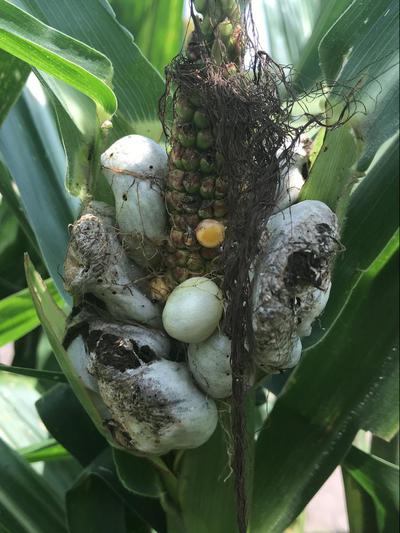Maize Smut
Ustilago maydis
Fungus
In a Nutshell
- Plant in the seedling stage show stunted growth and may not produce inflorescences or ears.
- On older plants, the infection results in the formation of galls full of black smut on ears.
- As they rupture, they show a powdery black content.
- On leaves, the tumorous growth usually remains small and dries out without rupturing.
Can also be found in
Symptoms
All actively growing parts of the plant can be infected with the fungus. Their predisposition to injuries and their growth potential makes them prone to show the most dramatic symptoms. Plants in the seedling stage are the most susceptible to infection. In that case, plant growth is stunted and they may not produce inflorescences or ears. On older plants, the infection results in the formation of tumorous growth, a combination of host and fungal tissues. Smut galls are greenish white at their early stages and turn black as they mature. They are particularly characteristic on ears, where each single kernel can develop its own gall. As they rupture, they show a powdery black content. On leaves, the tumorous growth usually remains small and dries out without rupturing.
Recommendations

Organic Control
Direct control of the fungus is difficult and ineffective method has been developed so far against this pathogenic fungi.

Chemical Control
Alway consider an integrated approach with preventive measures together with possible biological treatments. Seed and foliar applications of fungicides do not reduce the incidence of common smut infections in maize.
What caused it?
Common smut in maize is caused by the fungus Ustilago maydis, which can remain viable in the soil for several years. Spores spread onto the plants with wind, soil dust and rain splashes. The infection process is favoured by the presence of injuries, such as those inflicted by insects, animals, bad cultivation practices or hail. There is no direct secondary transmission from plant to plant. The symptoms are particularly severe in tissues with a huge growth potential (like ears or growing tips). Weather extremes that result in scanty pollen production and poor pollination rates (like a drought followed by heavy rain) are conducive to the propagation of the fungus.
Preventive Measures
- Cultivate tolerant varieties if available.
- Make sure to keep a wide space between plants.
- Monitor, collect and destroy galls before dark fungal spores are released.
- Prevent damage by insects and other pests.
- Avoid to damage the crops during cultivation practices.
- Make sure that tools and equipment are clean.
- Avoid excessive fertilisation with nitrogen.
- Remove all residue after harvest and do not compost infected plant parts.
- Plough deep to bury plant debris after harvest.
- Plan a long-term crop rotation with non-host plants.



